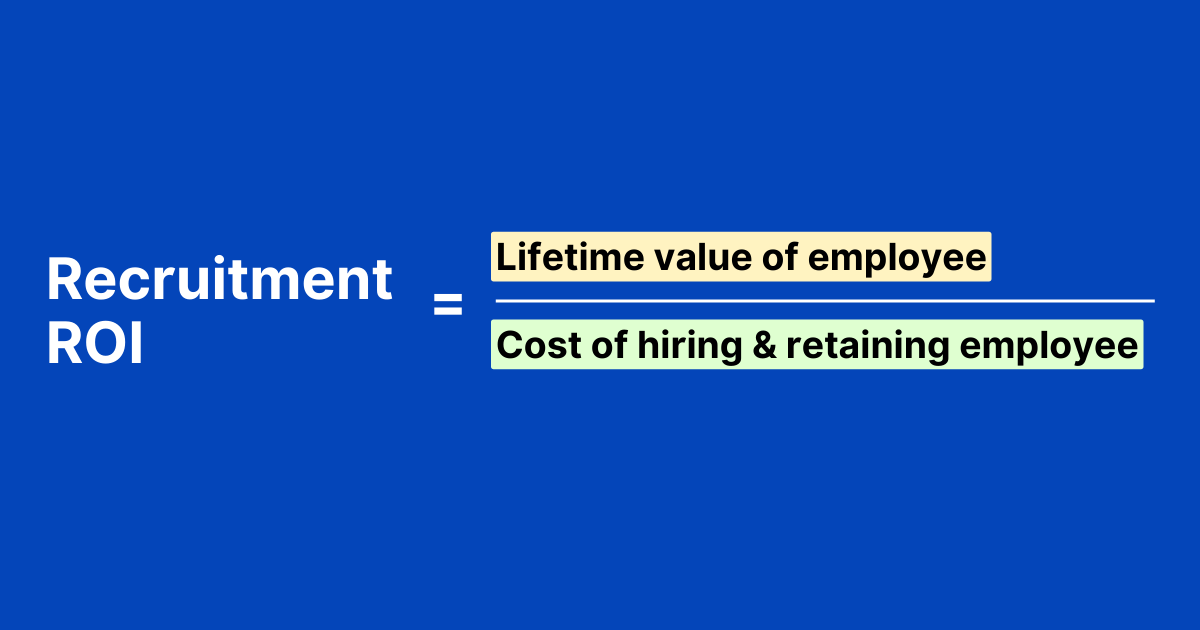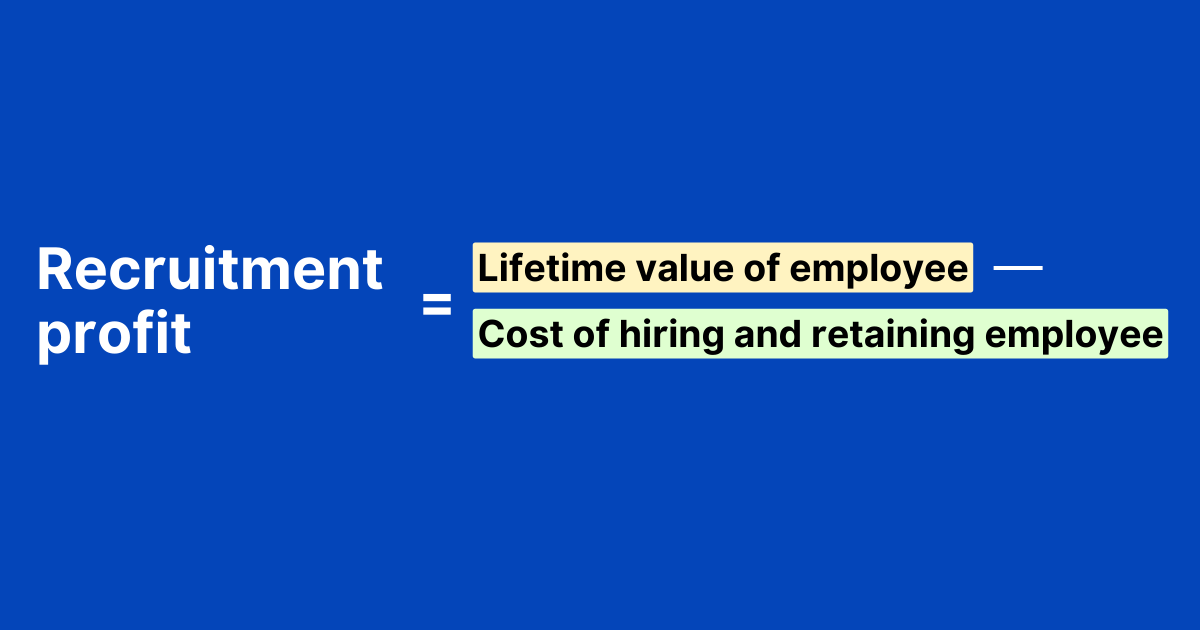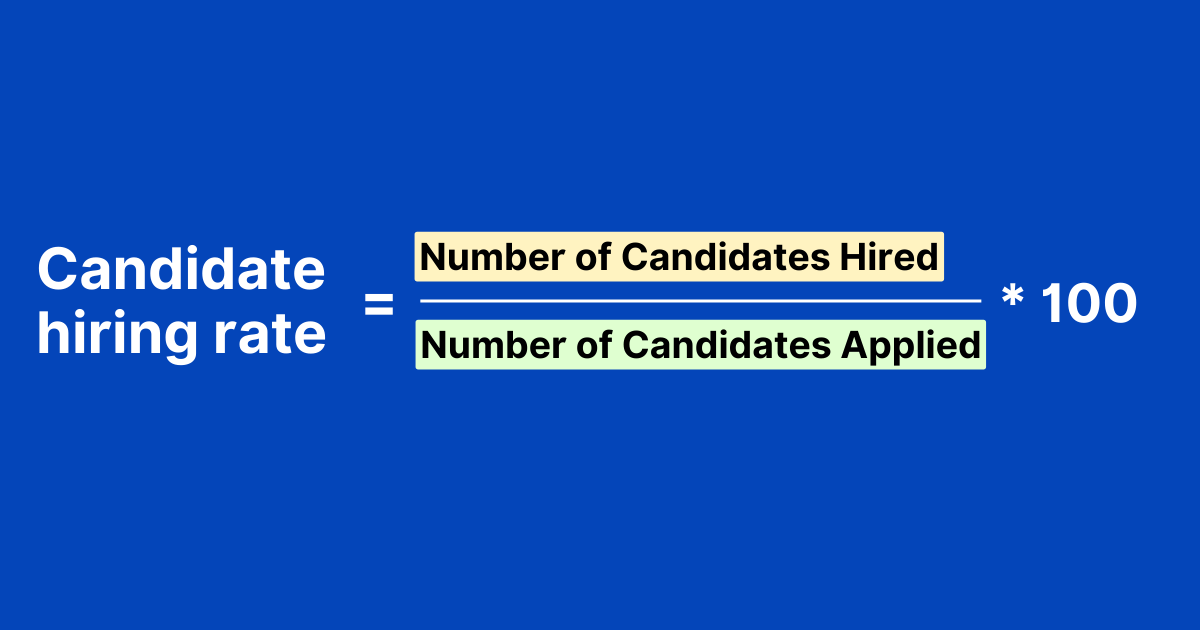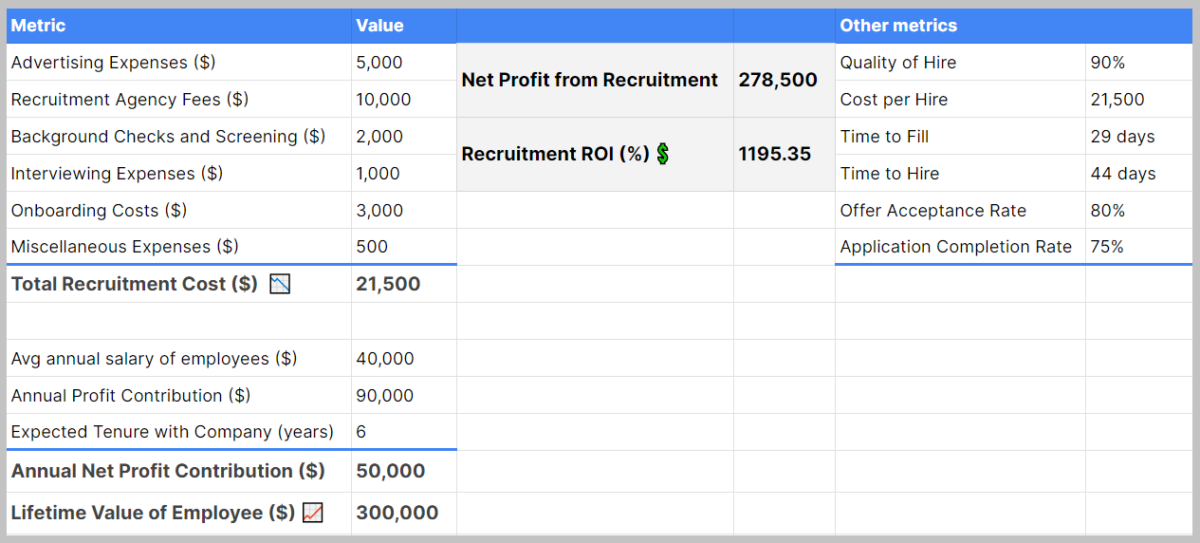
Every recruiting manager or talent manager responsible for hiring candidates will need to address the real ROI from the recruiting effort.
In simple terms, calculating ROI is simple once you know the total investment and net profit from the recruiting workflow.
However, in recruitment, the process may get complicated because of lots of hidden costs and identifying the profit from hiring candidates.
This guide will help you know what exactly is recruitment ROI and how to calculate it in actionable steps.
Most of all, we have imaginary examples to help you apply the formula and measure the ROI.
What is ROI in Recruitment?
Return-on-Investment (ROI) in recruitment is a metric used to measure the effectiveness and profitability of recruitment activities. It provides insights into the value generated from the resources invested in the recruitment process.
Put simply, ROI in recruitment calculates the return or benefits gained in relation to the costs incurred in attracting, hiring, and retaining talent.
By quantifying the impact of recruitment efforts, organizations can make data-driven decisions, optimize their recruitment strategies, and allocate resources more efficiently to achieve higher returns on their hiring investments.
👉 Related: Master these recruitment skills to improve your career in recruiting and hiring.
Recruitment ROI formula
The recruitment space is an evergreen niche, and it is important for every organization to measure their hiring strategies and see if they are getting the right ROI for the investments they make. But for that you need to know how to calculate Recruitment ROI, right?
The formula to calculate ROI (Return on Investment) is:

ROI = (Gain from Investment – Cost of Investment) / Cost of Investment
To specifically calculate Recruitment ROI, the following formula can be used:
Recruitment ROI = (Gain/Profit from Recruitment Investment – Recruitment Costs and Investment) / Recruitment Costs and Investment
Recruitment Costs and Investment include expenses such as advertising expenses, recruitment agency fees, background checks and screening costs, interviewing expenses, onboarding costs, and miscellaneous expenses.
Gain/Profit from Recruitment Investment is calculated by multiplying the value added by each employee with the number of employees recruited.
By applying the recruitment ROI formula, organizations can assess the effectiveness of their recruitment efforts and make informed decisions to optimize their hiring strategies and maximize their return on investment in recruitment activities.
How to calculate recruitment ROI?
Here’s a step-by-step process to calculate recruitment ROI:
Step 1. Define your recruitment objective
Every ROI measurement has to align with the business objective or the recruitment goals.

So, before measuring the returns and investment, clearly define the objective of your recruitment efforts, whether it’s to fill specific positions, improve the quality of hires, or enhance overall recruitment efficiency.
Here are some of the common recruitment objectives:
- Increase the number of qualified candidates
- Reduce the time to hire
- Improve the quality of hire
- Reduce the cost of hiring
- Improve the employee experience
Step 2. Calculate your recruitment cost
Gather all the relevant recruitment costs incurred during the defined period. These costs may include:
- Advertising Expenses: Total expenses on job advertisements, job boards, and other promotional activities.
How to calculate advertising expenses for recruitment:
| Activity | Cost |
| Job board posting | $200 |
| Online ad | $100 |
| Printed job postings | $50 |
| Total advertising expense | $350 |
| Number of job openings | 5 |
| Average advertising expense per job opening | ($350/5) = $70 |
- Recruitment Agency Fees: Costs associated with hiring external recruitment agencies.
- Background Checks and Screening: Expenses for conducting background checks, reference checks, and pre-employment screenings.
- Interviewing Expenses: Costs related to arranging and conducting interviews, including travel expenses if applicable.
Example of calculating offline interviewing expenses:
| Expense | Cost |
| Interviewer time | $100/hour |
| Travel expenses | $50/interview |
| Meals | $25/interview |
| Other expenses | $10/interview |
| Total offline interview expense | $185/interview |
Example of calculating online interviewing expenses:
| Expense | Cost |
| Video conferencing software | $50/month |
| Online whiteboard | $25/month |
| Document sharing | $10/month |
| Other expenses | $5/month |
| Total online interview expense | $90/month |
- Onboarding Costs: Expenditures involved in the orientation and training of new hires.
- Miscellaneous Expenses: Any additional recruitment-related costs, such as technology or software subscriptions.
Step 3. Calculate the net profit from the recruitment
To calculate the net profit, you need to estimate the value add each employee offers. And multiply this value by the total number of employees recruited in a specific period.
Net profit from recruitment = Lifetime value of employee – Cost of hiring and retaining employee

Here’s the typical chart showing the revenue generated from an employee over time:

Step 4. Measure the ROI on recruitment
The formula to calculate the Recruitment ROI:
Recruitment ROI = (Net Profit from Recruitment – Recruitment Costs) / Recruitment Costs
Recruitment ROI example
Let’s consider a hypothetical example to demonstrate how recruitment ROI can be calculated:
Step 1: Define your recruitment objective:
Let us assume the objective is to fill 10 positions within the organization.
Step 2: Calculate your recruitment cost:
Here is a rough estimate of recruitment costs. Feel free to add/remove costs that are not relevant to you.
| Expense item | Expense amount |
| Advertising Expenses | $5,000 |
| Recruitment Agency Fees | $3,000 |
| Background Checks and Screening | $1,500 |
| Interviewing Expenses | $2,000 |
| Onboarding Costs | $4,000 |
| Miscellaneous Expenses | $500 |
| Total Recruitment Costs | ($5,000 + $3,000 + $1,500 + $2,000 + $4,000 + $500) = $16,000 |
Step 3: Calculate the net profit from recruitment:
Let’s assume the value added by each employee is $50,000.
Total Employees Recruited = 10
Net Profit from Recruitment = $50,000 x 10 = $500,000
Step 4: Measure the ROI on recruitment:
Recruitment ROI = (Net Profit from Recruitment – Recruitment Costs) / Recruitment Costs
Recruitment ROI = ($500,000 – $16,000) / $16,000
Recruitment ROI = $484,000 / $16,000
Recruitment ROI = ₹30.25
In this example, the recruitment ROI is 30.25, which means for every dollar invested in recruitment, the organization gained $30.25.
This indicates a highly profitable recruitment process.
Remember, this is a simplified example, and actual recruitment ROI calculations may involve more factors and variables specific to each organization’s context.
KPIs/Metrics for recruitment
Okay now, its time to see some of the key performance indicators (KPIs) and metrics for recruitment, along with their importance:
1. Time to Fill
Tracking the time it takes to fill a position is crucial as it helps measure recruitment efficiency. A shorter time to fill indicates a streamlined hiring process, minimizing the risk of losing top talent to competitors.
2. Cost per Hire
Calculating the cost per hire provides insights into the financial investment required for each successful hire. This metric helps evaluate the effectiveness of recruitment strategies, identify cost-saving opportunities, and optimize budget allocation.
3. Quality of Hire
Measuring the quality of hire assesses the performance and contribution of new hires to the organization. This metric helps determine the effectiveness of recruitment methods, the accuracy of candidate assessment, and the overall alignment between candidate skills and job requirements.
4. Candidate Satisfaction
Monitoring candidate satisfaction during the recruitment process is essential to ensure a positive employer brand and attract top talent. This metric reflects the candidate’s experience and helps identify areas for improvement, enhancing the organization’s reputation and ability to attract high-quality candidates.
5. Retention Rate
Tracking the retention rate of newly hired employees provides insights into the effectiveness of the recruitment and selection process. A high retention rate indicates successful candidate matching, effective onboarding, and overall employee satisfaction.
6. Source of Hire
Analyzing the source of hire helps identify the most effective recruitment channels and sources for attracting top talent. This metric guides resource allocation, allowing recruiters to focus on channels that yield the best results and optimize recruitment strategies accordingly.
7. Offer Acceptance Rate
Measuring the offer acceptance rate provides insights into the attractiveness of the organization’s job offers and compensation packages. This metric helps assess the competitiveness of the organization’s offerings and adjust recruitment strategies to improve acceptance rates.
Tracking these KPIs and metrics enables recruiters and HR professionals to evaluate their recruitment efforts’ effectiveness, identify improvement areas, and make data-driven decisions to optimize the recruitment process and achieve better hiring outcomes.
How to calculate the candidate hiring rate?

The candidate hiring rate is a metric that measures the effectiveness of the recruitment process.
To calculate the candidate hiring rate, use the following formula:
Candidate Hiring Rate = (Number of Candidates Hired / Total Number of Candidates Applied) x 100
This formula calculates the percentage of candidates who were ultimately hired from the total pool of applicants. By monitoring the candidate hiring rate, organizations can assess the efficiency of their selection process, identify areas for improvement in candidate assessment and screening, and make data-driven decisions to enhance their recruitment strategies.
How to calculate the Time to fill

Time to fill is pretty self-explanatory that measures the average amount of time it takes to fill a job vacancy.
Time to Fill = (Date the Position is Filled – Date the Position is Opened)
By measuring the time to fill, organizations can assess the speed and effectiveness of their recruitment process. A shorter time to fill indicates that the organization can quickly identify and attract suitable candidates, reducing the time and cost associated with job vacancies.
How do you calculate ROI manually?
ROI is nothing but a simple financial metric that measures the profitability of the investment made. If we see it in the context of mass recruiting, it is all about the value generated by the employees hired.
Here is the general formula to calculate ROI.
ROI = (Net Profit – Cost of Investment) / Cost of Investment
Calculating ROI helps in getting valuable insights into the investment an organization makes for its hiring process.
How to calculate applicant-to-hire ratio

The applicant-to-hire ratio is a recruitment metric measuring the number of applicants hired successfully.
To calculate the applicant-to-hire ratio, divide the total number of applicants by the number of hires made during a specific period. The formula is as follows:
Applicant-to-Hire Ratio = Total Number of Applicants / Number of Hires
How to calculate an offer acceptance rate
The offer acceptance rate is a recruitment metric that measures the percentage of job offers extended by an organization that is accepted by candidates.
To calculate the offer acceptance rate, we have just to divide the number of job offers accepted by the total number of job offers extended.
The formula is:
Offer Acceptance Rate = (Number of Job Offers Accepted / Total Number of Job Offers Extended) * 100
Calculating the offer acceptance rate is important for several reasons. It helps recruiters assess the attractiveness of the job offer, the competitiveness of the compensation package, and the overall candidate experience during the recruitment process.
A high offer acceptance rate indicates that the organization is successfully attracting and engaging top candidates, while a low rate may indicate a need to re-evaluate and improve aspects of the job offer or recruitment process.
By monitoring the offer acceptance rate, recruiters can identify areas for improvement and take proactive measures to increase the acceptance rate.
- This may involve analyzing:
Market benchmarks - Conducting candidate feedback surveys
- Fine-tuning the compensation package
- Benefits and other aspects of the job offer to align with candidate expectations
Improving the offer acceptance rate contributes to a more efficient and successful hiring process, ensuring the organization can secure top talent for key positions.
Key challenges of measuring Recruitment ROI
It is important to be aware of the common hiring challenges you will face while measuring the ROI of recruitment.
I will also share some recommendations from our talent acquisition experts that you can practice along the way.
👉 Check out the key talent acquisition trends of this year
1. Recruitment attribution is flawed
Recruitment attribution refers to the process of attributing the source or channel that led to a successful hire. Several factors contribute to this, such as multiple touchpoints throughout the candidate journey, reliance on self-reported data, and the influence of external factors.
How to deal with this challenge:
- Implement advanced tracking and analytics tools to capture and analyze recruitment data accurately.
- Use candidate surveys and feedback mechanisms to gather insights on their journey and the channels that influenced their decision to apply.
- Leverage technology solutions, such as WebPipl’s recruitment suite that provide comprehensive tracking and attribution features.
- Continuously evaluate and refine your attribution model based on data-driven insights and industry best practices.
By addressing recruitment attribution challenges, recruiters can better understand their sourcing channels’ effectiveness and make informed decisions to optimize their recruitment strategies.
2. Forecasting employee lifetime value (LTV)
Forecasting employee lifetime value (LTV) refers to estimating the value an employee will bring to the organization over their tenure. This presents a challenge for recruiters as it requires predicting future performance, productivity, and contribution of candidates during the hiring process.
How to deal with this challenge:
- Implement data-driven approaches to assess candidate potential and fit for the organization.
- Leverage past performance data and employee success metrics to identify patterns and predictors of long-term value.
- Collaborate closely with hiring managers and subject matter experts to gather insights on the critical success factors for different roles.
- Continuously monitor and evaluate employee performance and development to refine the accuracy of LTV forecasts.
Recruiters can enhance their ability to forecast employee lifetime value, making more informed hiring decisions and maximizing the long-term impact of their recruitment efforts.
3. Huge time gap between “recruitment investment” and “generating return” periods
This is another big challenge. This gap can be frustrating for recruiters as it may take time for new hires to ramp up, contribute to the organization, and deliver measurable results.
How to deal with this challenge:
- Implement efficient onboarding processes to accelerate the integration of new hires and enable them to start adding value sooner.
- Set realistic expectations with stakeholders about the time it takes for new hires to reach full productivity and communicate the long-term benefits of investing in recruitment.
- Continuously monitor and evaluate the performance and progress of new hires to identify any areas for improvement or additional support.
- Implement performance-based incentives or rewards to motivate and incentivize new hires to deliver results quickly.
If this challenge is addressed, recruiters can reduce the time gap between recruitment investment and generating returns, ensuring a more efficient and impactful recruitment process.
4. Lack of data to calculate the actual recruitment cost involved
Another challenge in recruitment is the lack of comprehensive data to calculate the actual recruitment cost involved. How can we then expect to have accuracy? This is quite a challenge.
How to deal with this challenge:
- Implement robust applicant tracking systems (ATS) to track and capture relevant recruitment data, including recruitment sourcing channels, advertising costs, and time spent on each stage of the recruitment process.
- Regularly review and analyze recruitment data to identify patterns, trends, and areas for improvement.
- Establish standardized metrics and benchmarks to measure and compare recruitment costs across different positions, departments, or time periods.
- Leverage industry research, benchmarking data, and external resources to gain insights into typical recruitment costs in the market.
By addressing the lack of data challenge and implementing effective data collection and analysis strategies, recruiters can better understand their recruitment costs and make data-driven decisions to optimize their recruitment processes.
Recruitment ROI Calculator
If the calculation part seems complex to you, check out our recruitment ROI calculator Google sheet.
Here’s a sneak peek:

The best part, you will find the calculation of recruitment ROI with sample data.
📄 Open and download the editable recruitment ROI calculator (Google sheet template)
Using this Recruitment ROI Calculator can provide valuable insights into your recruitment efforts’ effectiveness and profitability.
How to maximize your recruitment ROI using WebPipl
To maximize your recruitment ROI using WebPipl, you can take advantage of its various features and tools. Firstly, streamline your candidate sourcing process by utilizing WebPipl’s AI-powered candidate sourcing tools, which quickly analyze profiles to identify top talent.
Our AI-assisted recruitment tools help recruiters
- iVerified, fastest video interviewing software
- Applicant tracking software
- Candidate sourcing tool
- AI-driven recruitment software
- iAssess, a Candidate assessment tool
Focus on enhancing candidate experience by using WebPipl’s candidate feedback tools, gathering valuable insights to improve satisfaction and attract top talent.
By incorporating these strategies and utilizing WebPipl’s suite of recruitment tools; you can optimize your recruitment efforts, improve efficiency, and ultimately maximize your recruitment ROI.

Raju Thammala is the founder of WebPipl, an AI-based recruitment company revolutionizing the tech hiring process with products like video interviews, ATS software, etc.
As CEO and founder, Raju Thammala is passionate about leveraging technology to deliver next-gen recruiting services. In his free time, Raju enjoys reading and exploring new cuisines or jet-setting to exotic destinations.
